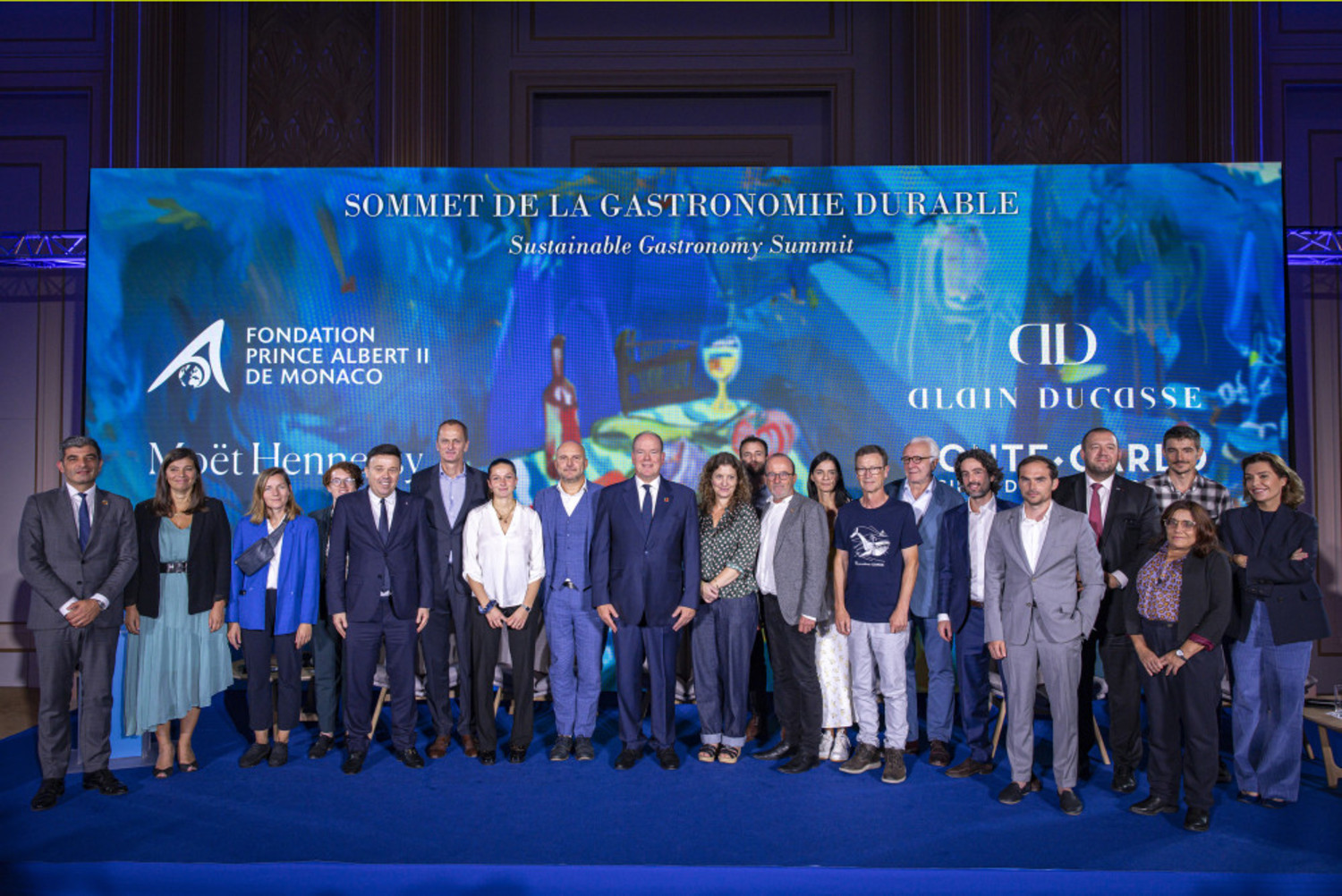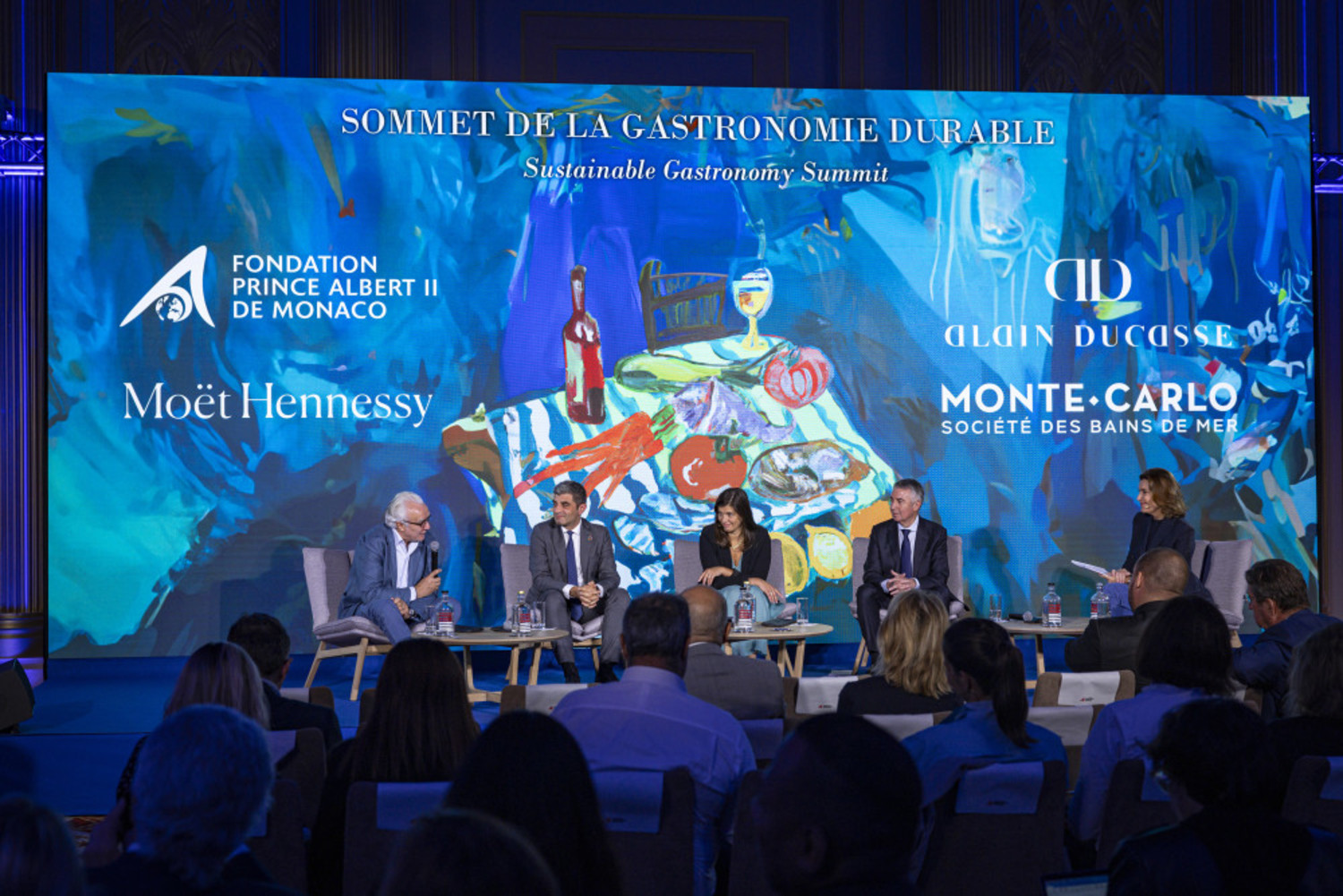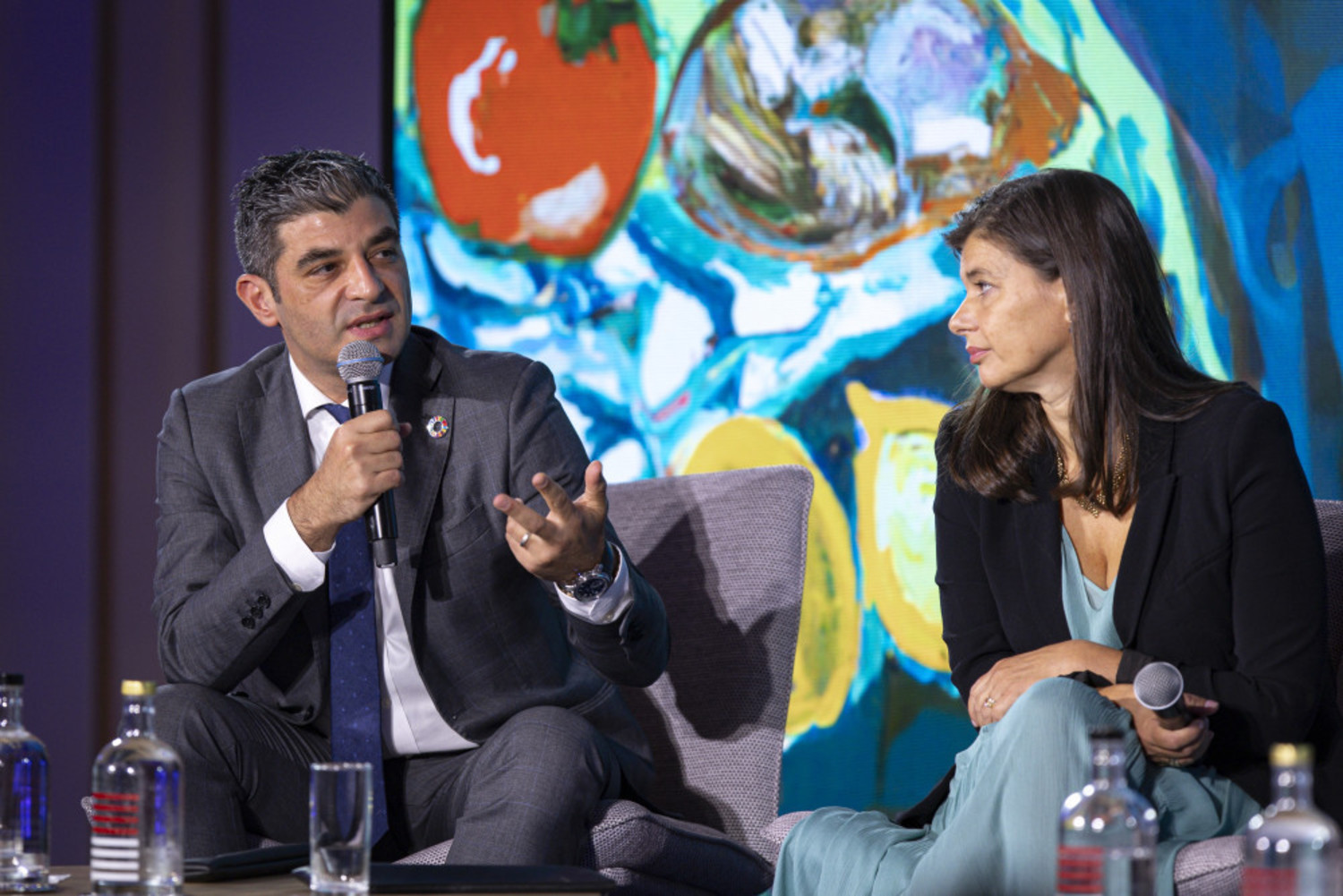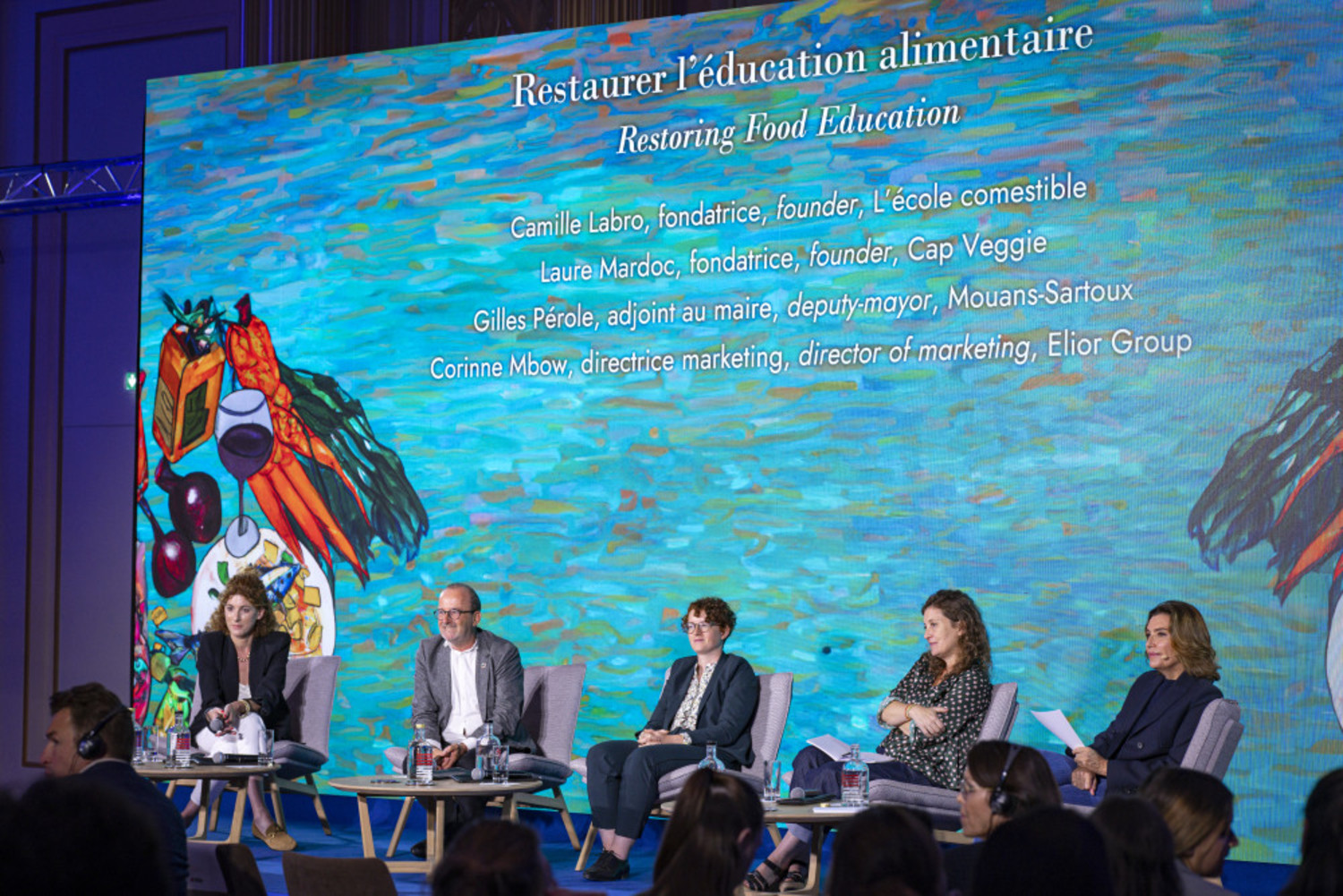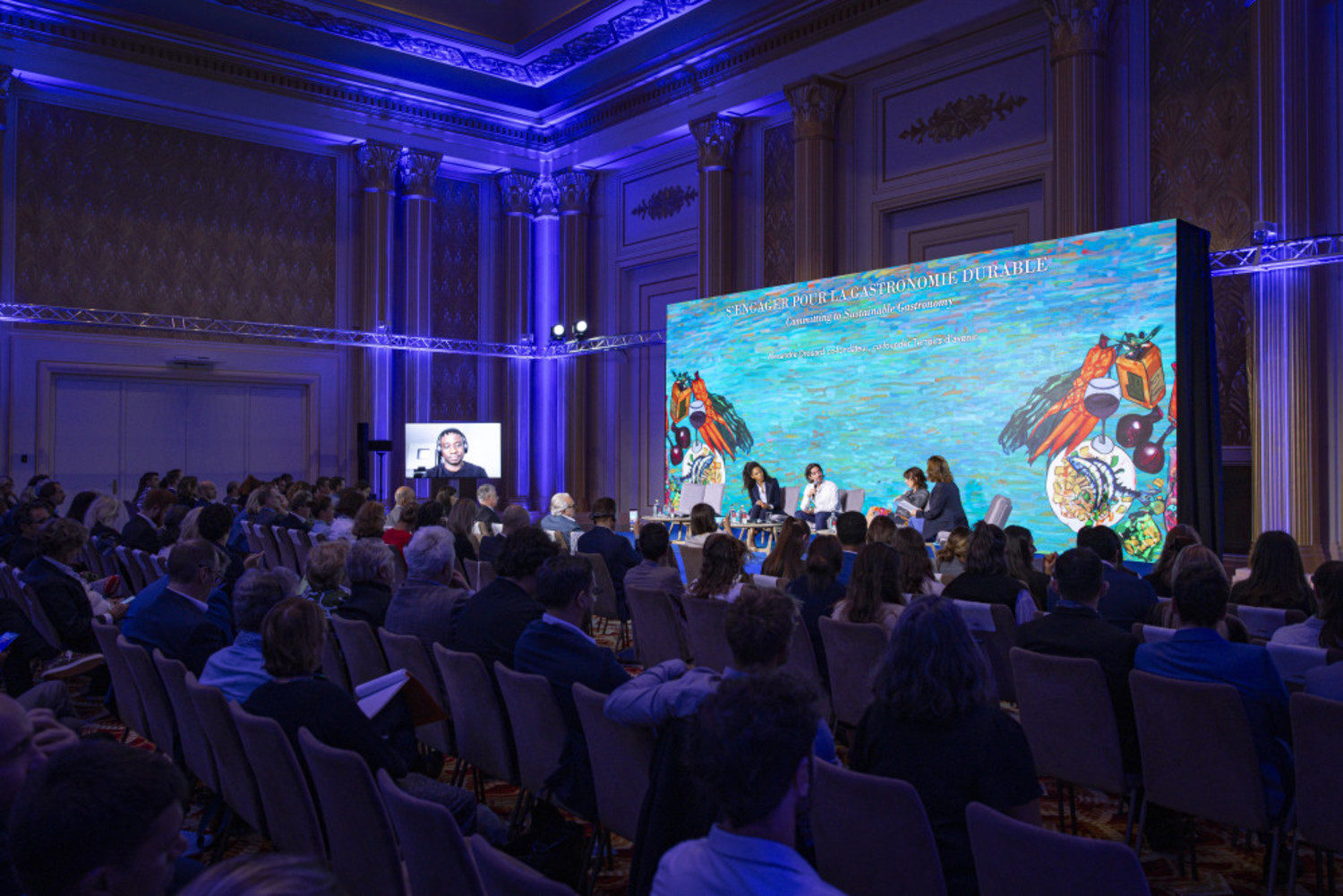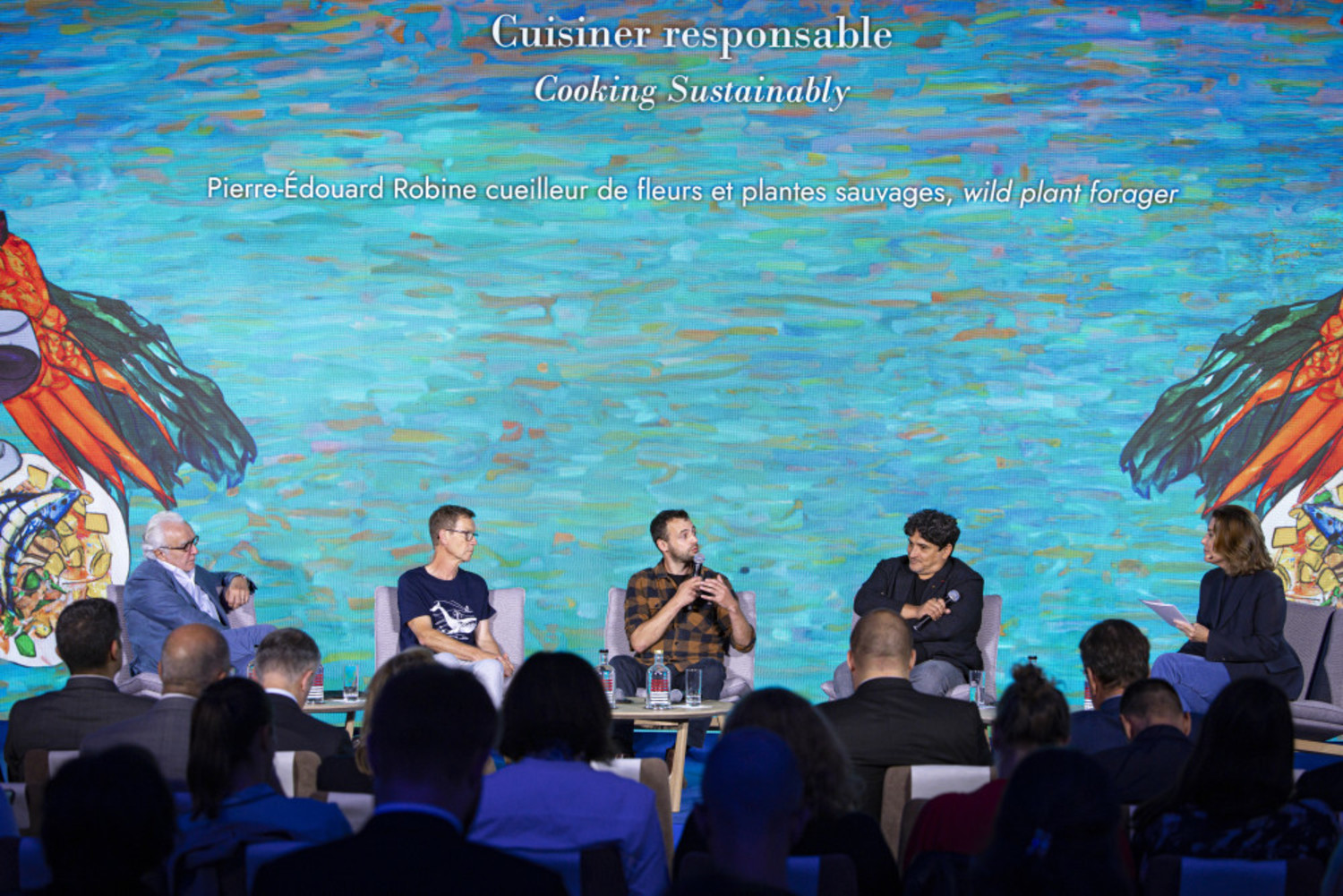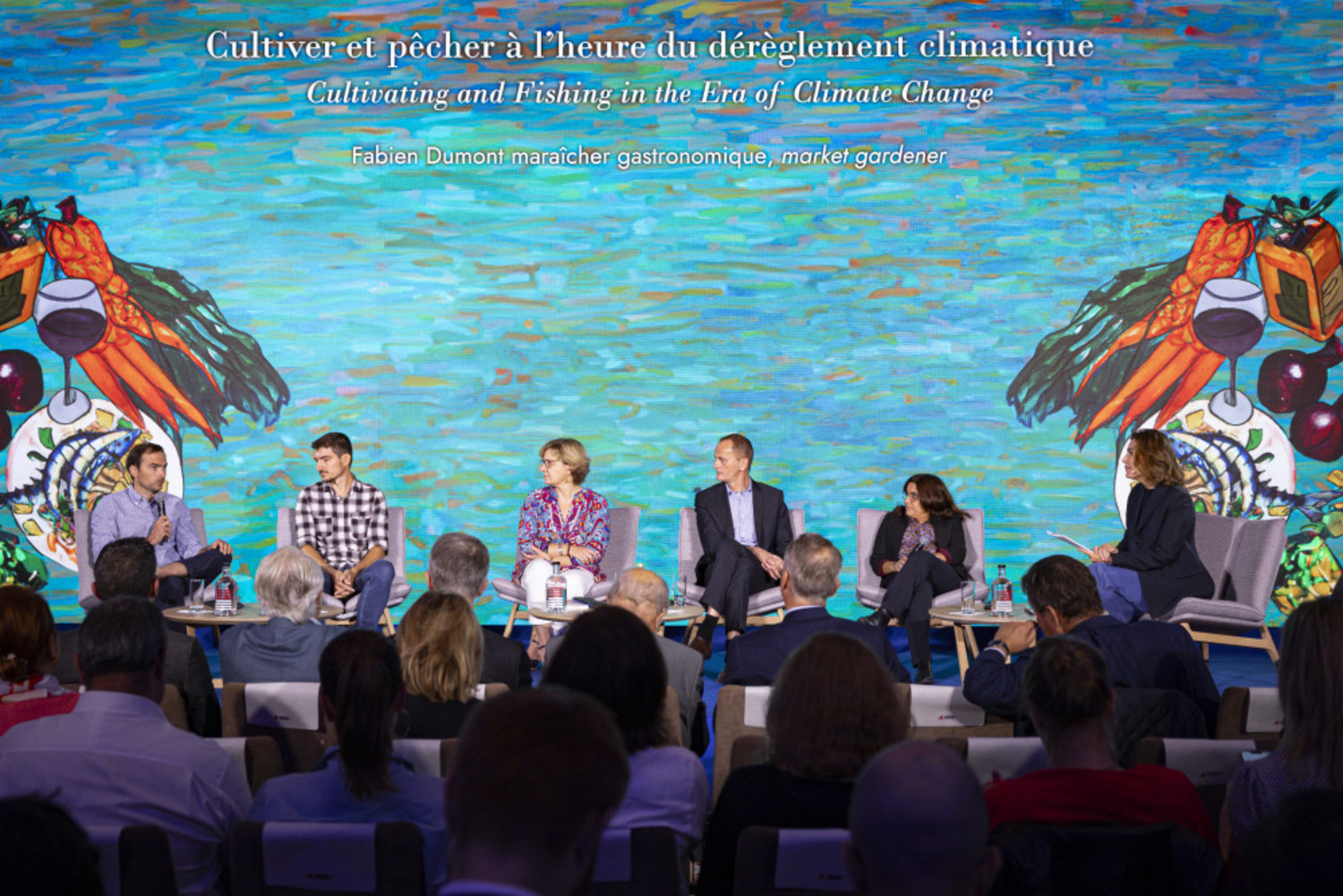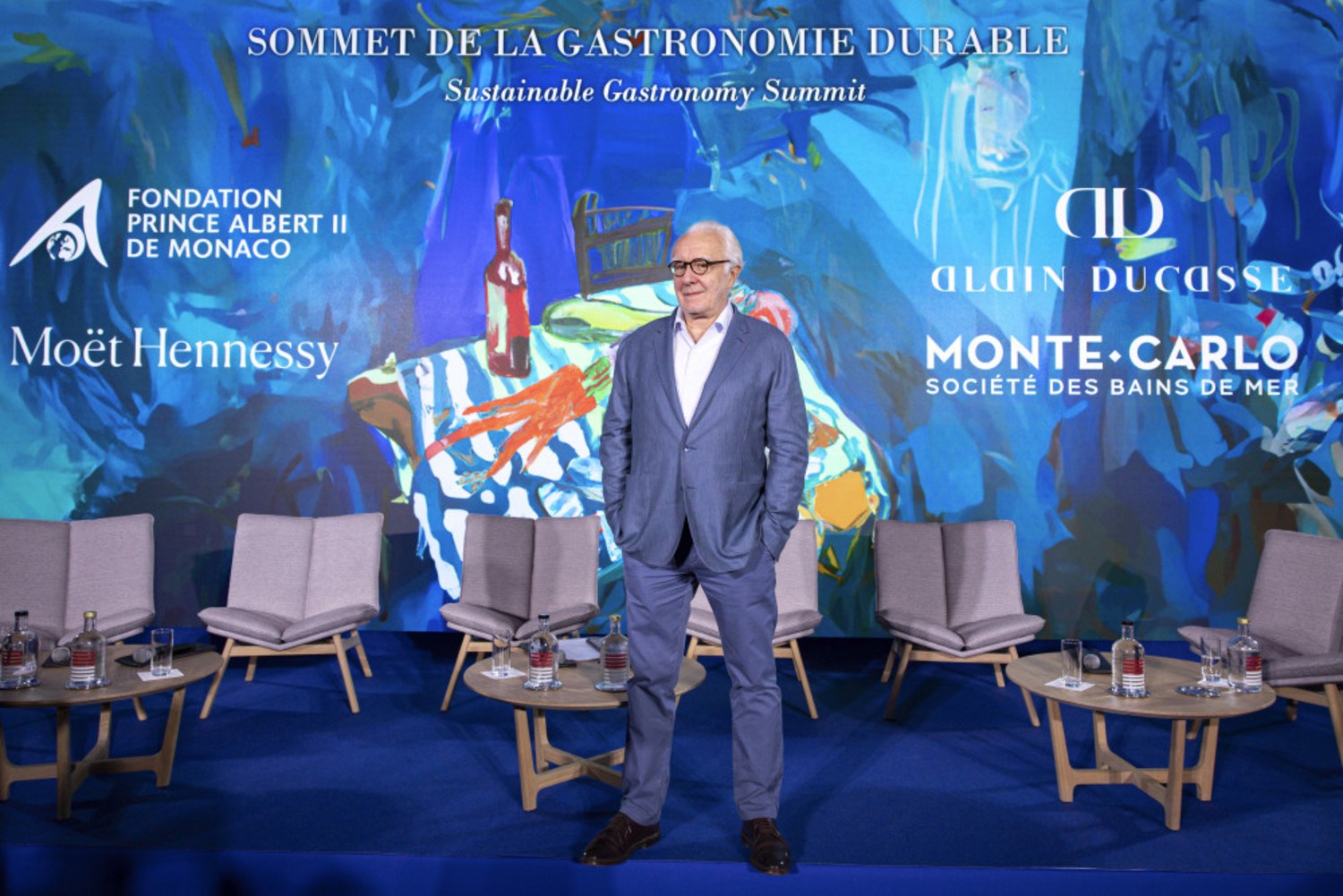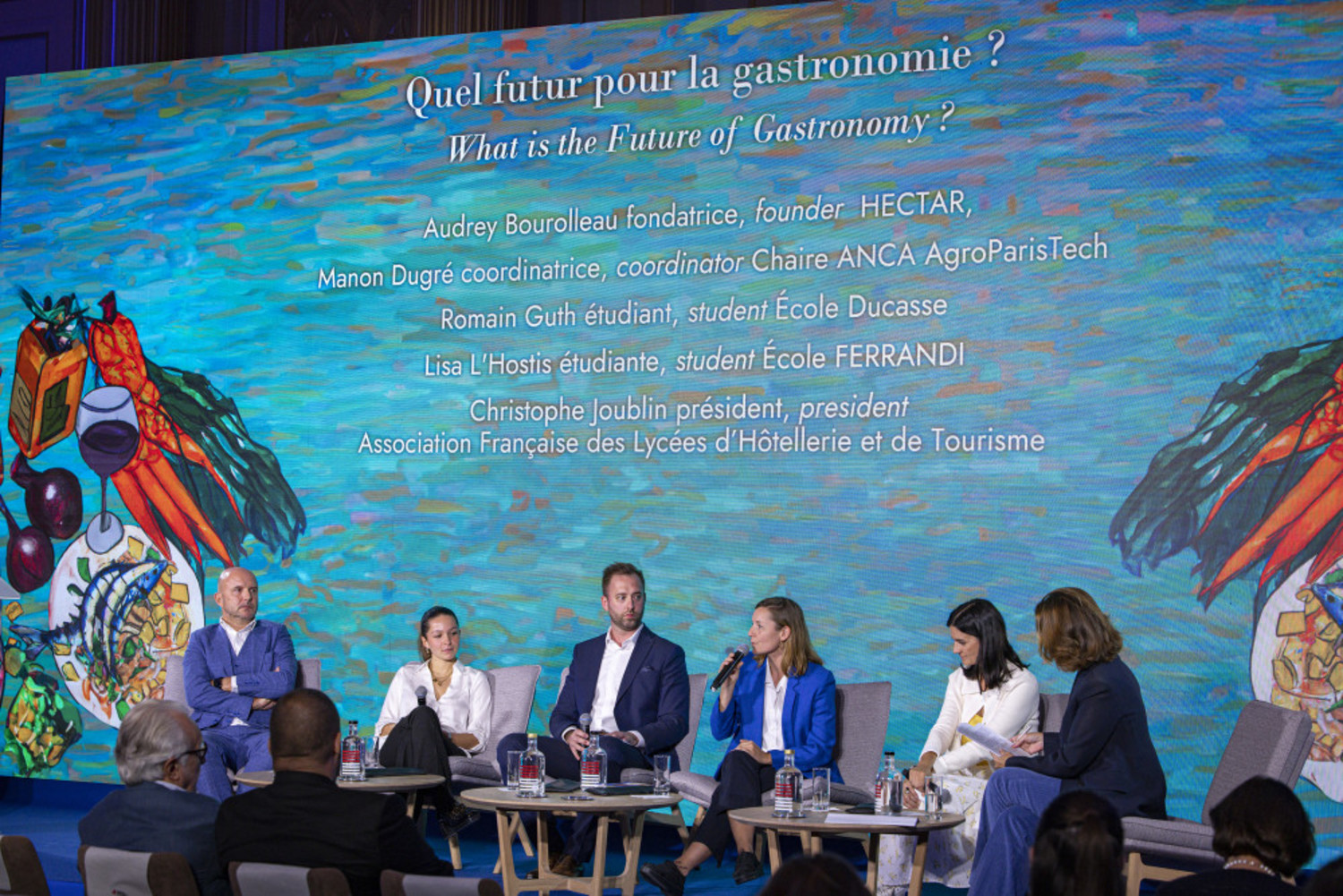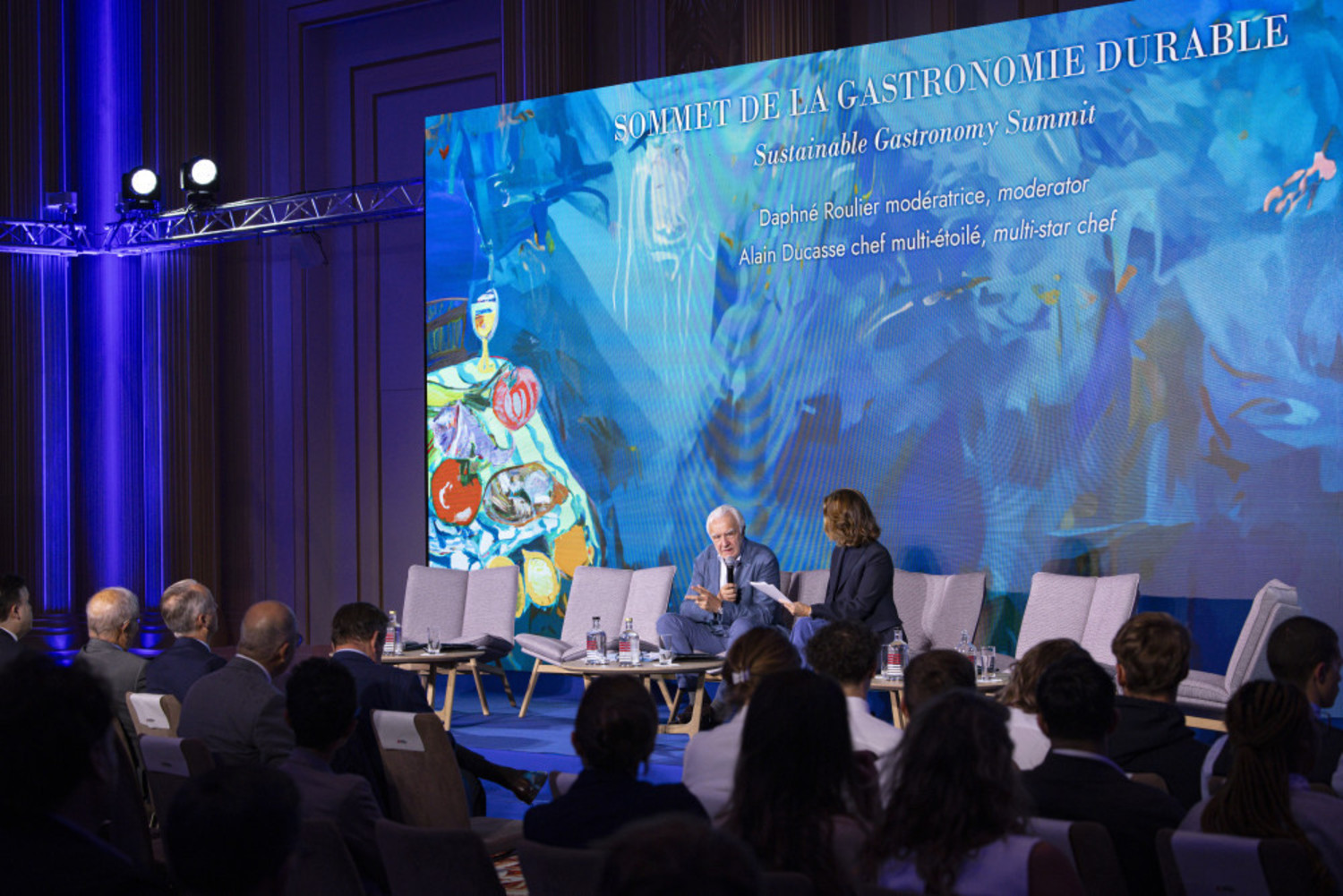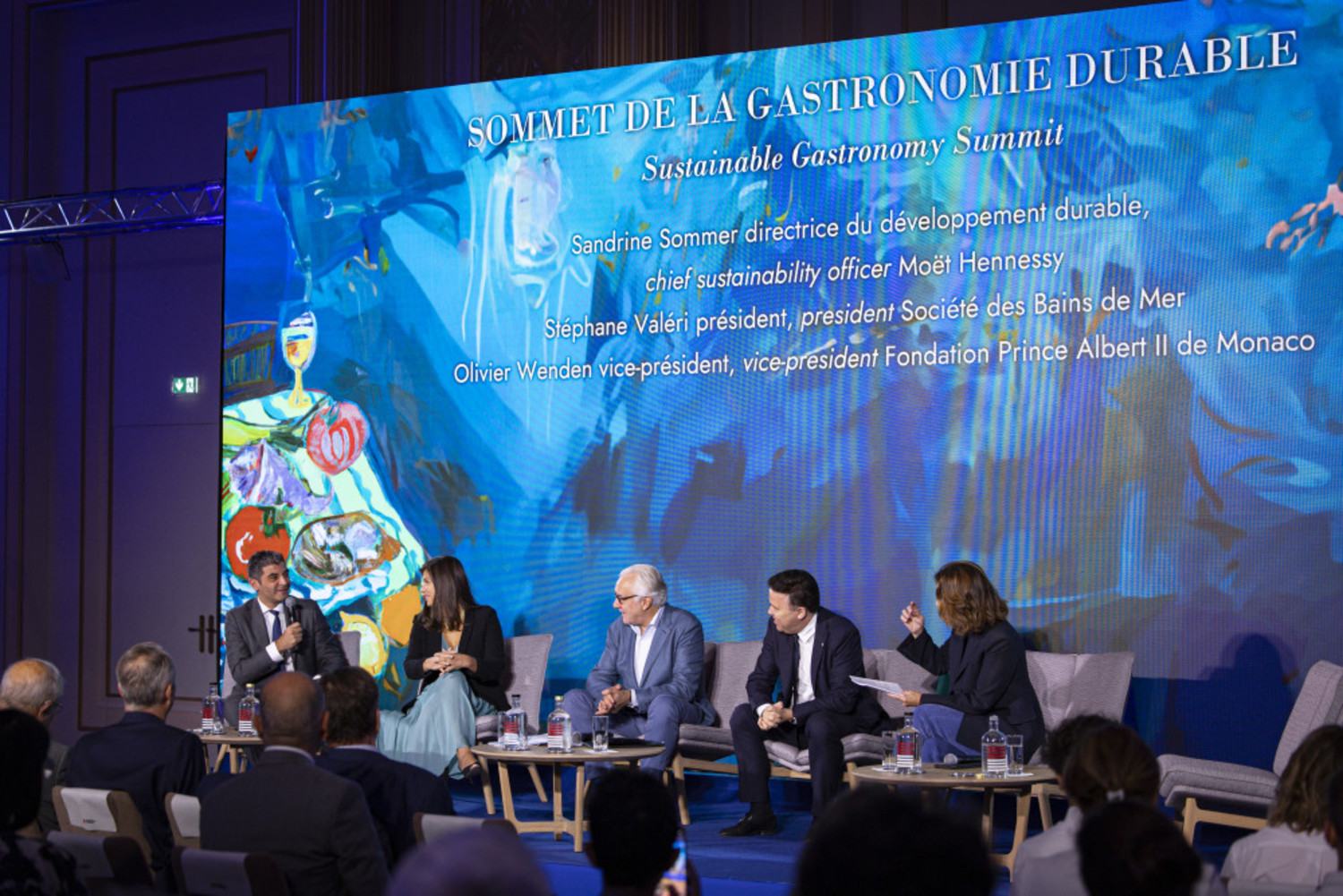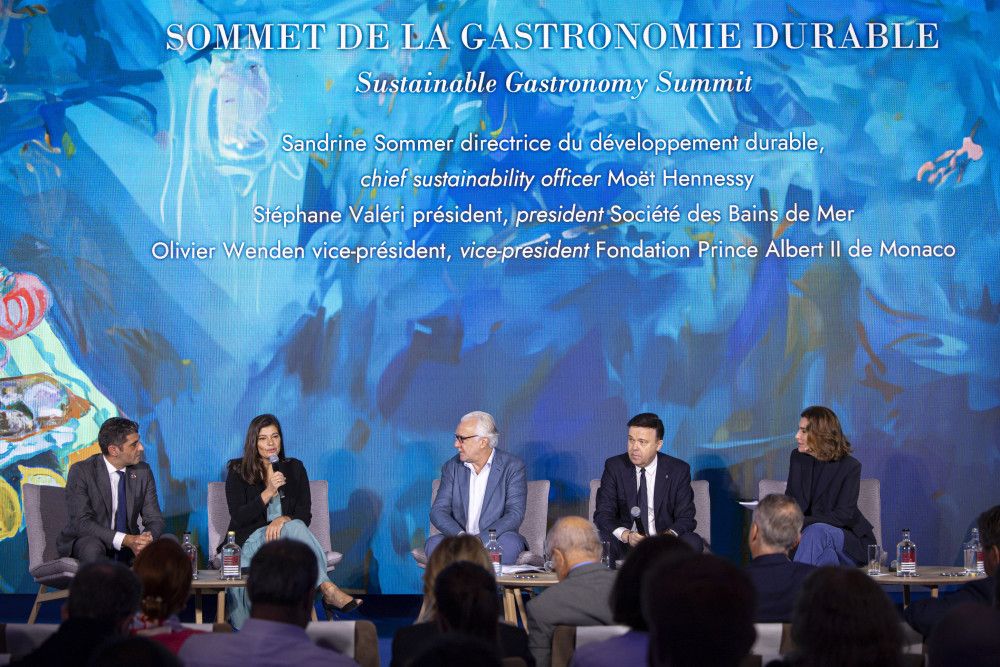
1st edition of the Sustainable Gastronomy Summit
Monaco
Events
Press release
On Thursday 21 September 2023, the 1st edition
of the Sustainable Gastronomy Summit was held under the High Patronage of HSH
Prince Albert II of Monaco, organised by Alain Ducasse, in collaboration with
the Prince Albert II of Monaco Foundation, with the support of Moët Hennessy
and the Société des Bains de Mer.
Live from One Monte-Carlo in Monaco, this day of professional
exchanges and collective reflection was hosted by French journalist Daphné
Roulier. It was structured around five major themes that addressed the
challenges of sustainable gastronomy. Discover below the highlights of each
session, revealing the ideas and solutions that marked this exceptional day.
Cultivating and Fishing in the Era of Climate Change
- Fabien Dumont, Market gardener, Saint-Rémy-de-Provence
- Sylvain Pagnon, Fisherman, Carro
- Elisabeth Vallet, Director Ethic Ocean, Paris
- Christophe Maier, CEO Lagosta, Monaco
- Eva Moreno, Paleo-climatologist Museum of Natural History, Paris
At the first session of the Sustainable Gastronomy Summit 2023, “Cultivating and Fishing in the Era of Climate Change”, panelists discussed the importance sourcing sustainably, and adapting to climate change through eco-conscious agricultural and fishing practices.
Sixty-five million years ago, at the time of the dinosaurs, temperatures were 10 degrees higher than they are now and there was more CO2 in the atmosphere. Today, “temperatures are increasing faster than we have seen in thousands of years,” said Eva Moreno,Paleoclimatologist at the Paris Natural History Museum.
The ocean plays a key role in mitigating climate change as it captures CO2 from the atmosphere, acting as a carbon sink, and also absorbs excess heat from the earth, lowering temperatures. “Without our oceans, NY could reach 70°C (160°F),” Moreno added. Nevertheless, marine heat waves – periods of five days or more when temperatures exceed their average – have been seen for the past 30 years, and they are devastating to ecosystems, but they are not the only threat to aquatic life, as overfishing threatens populations, which results in fewer predators and certain species proliferating in excess.
Climate change affects everyone, including farmers. During the panel, Fabien Dumont, Market gardener from Saint-Rémy-de-Provence explained how he and his wife have done extensive research on different vegetables adapted to various climates, including ancient varieties, tomatoes from Sicily and round cucumbers. “When I started, the climate was fine, but now seasons are changing unpredictably, but thanks to the work I have done, I can choose the variety of tomato I know will grow best in those conditions.” His family is thus able to supply the local community with diverse and flavorful produce.
Artisanal fishermen like Sylvain Pagnon, who uses his mechanical engineering degree to help the environment, go to great lengths to ensure their activities are respectful of the delicate balance within our oceans. He learned the trade from his father, who also has a doctorate in ecology. “In the Mediterranean,” he said, “the artisanal fishermen limit fishing zones. We make decisions together and adapt to the fish we find, just as growers adapt to seasons.” As a community, they monitor fish populations, not capturing species with reduced numbers or during their reproduction. “Red tuna, quotas saved the species. It is very positive,” he added.
Another way to protect species is by sustainably farming them and replenishing populations, which is the mission of Christophe Maier at Lagosta in Monaco. Using advanced technology, Lagosta re-creates the ideal environment for European spiny lobsters to thrive and provides them with high quality organic food, which results in a sixfold increase in natural repopulation rate. “Lobsters are extremely sensitive in terms of their environment and food. It is important to know the animal and its needs,” he says. After a certain period, Lagosta releases the crustaceans into the Mediterranean with a digital tag on their shells so they can follow their well-being. “We put great care into making sure this species’ population will survive sustainably in the wild.” The group also recycles the exoskeletons shed by the lobsters during their maturation.
Restaurants and consumers can also have an impact, according to Elisabeth Vallet, Director of Ethic Océan, which provides scientific data establishing purchasing recommendations to help professional buyers choose species that are not overexploited. “86% of fish on the market are the result of overfishing, but science allows us to establish purchasing recommendations to choose fish that are not overexploited. Everyone can verify the information from their fish supplier or restaurant to ensure they are consuming responsibly,” she asserted. By choosing a species of fish that is more abundant in the oceans, looking to small fish, deep-sea fish or even river fish, and adapting selections throughout the year, consumers can alleviate the strain on our oceans, and chefs can influence countless people with their menus. All this information is accessible at guidedesespeces.org/fr, as well as via a mobile app.
While food professionals like Pagnon, Maeir and Vallet are making a difference for the better, there are still some fishermen who do not respect these responsible practices, which makes it necessary to have formal government regulations to ensure everyone follows the rules.
KEY TAKEAWAYS
Consuming local and sustainable products can make a difference in global warming.
While many artisanal fishermen agree together to respect the ecosystem, government regulations are necessary to prevent those who disregard these best practices.
Consumers choices can influence marine ecosystems for the better, and purchasing recommendations based on scientific research are available to everyone.
Cooking Sustainably
- Pierre-Édouard Robine, Wild plant forager, Écouché-les-Vallées
- Jean-Marie Pédron, Seaweed harvester, Le Croisic
- Alain Ducasse, Multi-star chef
- Mauro Colagreco, Michelin star chef Mirazur, Menton
From seaweed farming to foraging wild plants and exploring new varieties of deep-sea fish to relieve pressure on overexploited species, this discussion shed light on how our choices as consumers can impact the future of food.
“Haute Gastronomy is only the tip of the iceberg,” began Alain Ducasse, “millions of people eat out and for them to eat well, we need to change the way we offer them food. As chefs, we are responsible for movements in consumption, and it is up to us to use our influence to change it.” He added that “seaweed is one of the keys to eating better.”
Indeed, the virtues of edible seaweed are abundant, as Mauro Colagreco pointed out, “seaweeds are C4 plants, which capture more CO2. They have a great impact on the planet, along with the Amazon, they are the lungs of the Earth.” Indeed, seaweed is responsible for producing half of the oxygen we breathe.
As an added bonus, seaweed can regenerate more quickly than terrestrial crops, as explained by seaweed harvester, Jean-Marie Pédron, who shared: “In a harvest season, I can sustainably gather the same biomass three times because it regenerates so quickly.” Nevertheless, he does so responsibly, as he only collects 1/3 of the bunch, leaving one third for fish to eat and 1/3 so the plant can grow back, keeping it circular. Furthermore, he pointed out that seaweed is grown without fertilizer, herbicide or pesticide. Nevertheless, despite France’s 5,500km of coast, only 5% of the nation’s seaweed is eaten. “The Japanese are envious of our potential to grow seaweed along the Atlantic,” he said happily. Pédron also reminded the audience that in the 1950s, seaweed foraging was a common practice in France, but this culture has been lost.
Wild plant forager in Écouché-les-Vallées, Pierre-Édouard Robine – also an environmentalist and ornithologist – only collects wild plants, which he supplies to fine restaurants. He likens his approach to haute couture, where new local ingredients with completely new flavors and attributes enliven a recipe. “Gastronomy can evolve within a micro-region. Rather than brining exotic products from abroad, you can find extraordinary wild plants at home. Each person should be able to access this type of food,” he explained.
Both Ducasse and Colagreco echoed the importance of keeping consumption local. “In my restaurants, we use what we have locally. It is a movement that won’t stop,” stated Ducasse.
At Mirazur in Menton, Colagreco has a 3-hectare garden that dictates the rhythm of the kitchen. “While not everyone can grow their own produce, anyone can opt to work with quality artisan suppliers. We shape the world we live in by how we choose to eat,” he said. Mirazur also happens to be the first restaurant to be plastic-free, a feat which took years to achieve.
Closing the topic of responsible sourcing, Ducasse brough the discussion back to future generations: “We have 2,000 students in the world learning the art of French cuisine: to cook, source responsibly, reduce waste and respect the environment. Engaging these chefs of tomorrow is one of the ways we accelerate the movement.”
KEY TAKEAWAYS:
Chefs have the power to make sustainable gastronomy a reality.
Seaweed is an underutilized resource that benefits the environment and can be cultivated sustainably.
Foraging wild plants is a sustainable alternative to import and allows for the discovery of myriad flavorful options.
Committing to Sustainable Gastronomy
- Alexandre Drouard, Co-founder Terroirs d’Avenir, Paris
- Fanny Giansetto, Co-founder Écotable, Paris
- Elisabeth Boucher-Anselin, Communications Director Michelin Guide, Paris
- Dieuveil Malonga, Chef of Meza Malonga and social entrepreneur, Kigali, Rwanda
The future of gastronomy is sustainable, and restaurants deserve both
support and recognition in their efforts to achieve this goal. The panel
addressed how we can ensure the longevity of gastronomy through better
practices and keeping traditions alive.
Labels like Écotable are a way restaurateurs can showcase their commitments to sustainability, but Fanny Giansetto reminds us, “The Écotable label is only a small part of what we do. We want to mobilize the masses and do so by helping restaurants understand their environmental impact and showing them ways they can adopt sustainable practices affordably.” She pointed out that often, restaurateurs have the desire to be sustainable but worry the transition would be costly. Écotable helps them understand viable changes they can make. “By reducing food waste, one can increase turnover by 30%,” was an example she cited. Écotable has over 200 criteria from sustainable, organic products, to food waste, waste in general, and energy consumption to parameters that measure carbon impact and biodiversity. “We try to have the most holistic vision possible,” she added.
Another label has gained tremendous momentum as of late. “With the Green Michelin Star, we recognize the pioneers – chefs with the bravery to dare, always moving forward on a new sustainable path. They are the ones who will write the next chapter of gastronomy.” said Elisabeth Boucher-Anselin. Today, 3,000 restaurants have a Michelin Star and 458 have Green Michelin Star – and sometimes, there is no overlap between the two. The emblematic guide had been searching for a way to reward bold chefs around the world taking large strides for the advancement of sustainable gastronomy. “We have never been so solicited by establishments who want to get this distinction. The Green Star has created a federated community among restaurateurs, and clients become ambassadors of the approach,” she added.
Speaking of communities, Alexandre Drouard of Terroirs d’Avenir promotes small-scale agriculture. “We have built a network of 300 rural farmers in France, Italy and Spain. If we want to be able to continue to cook and have an impact, the grower is the first link in the chain,” he stated. His approach is an excellent illustration of Ducasse’s conclusion that “going back to naturality is better for the health of people and the planet. We need to re-establish a connection between the consumer, restaurateurs.”
This philosophy has taken hold amongst chefs and restaurateur around the world, including in Rwanda, where Dieuveil Malonga has made it his mission to connect with the culinary traditions throughout the continent. “Many countries in Africa do not have cookbooks. I spent two years traveling the continent, recording recipes passed down through oral tradition, and keep them alive by training young aspiring chefs.” After living in France and Germany, Malonga visited 48 African countries, collected 518 jars of seeds, and fell in love with Rwanda for the richness of its volcanic soils, on which chemicals have never been used.
Indeed, a relationship between supplier, restaurateur, consumer and earth completes the circle. Only by understanding and respecting each link in the chain and supporting each other can we ensure the future of gastronomy.
KEY TAKEAWAYS:
Restaurants deserve recognition and support for their efforts to become more sustainable.
With new labels related to sustainability, consumers can choose their culinary establishment based on these criteria for a more meaningful dining experience.
We are a global community, from rural farmers to indigenous populations, everyone deserves to be heard and valued as a link in the chain.
Restoring Food Education
- Gilles Pérole, Deputy-Mayor Mouans-Sartoux
- Laure Mardoc, Founder Cap Veggie, Paris
- Camille Labro, Founder L’école comestible, Paris
- Corinne Mbow, Director of Marketing Elior Group, Paris
This roundtable underscored the importance of education and awareness about food origin, healthy choices and cooking – and taking initiative when solutions are absent. Instilling good habits and values at an early age sets children on the right path for a sustainable future.
A balanced diet is a child’s fundamental right and school cafeterias are the primary way the French food model is passed on. In vulnerable areas, canteens also enable children to explain the benefits of preparation methods and quality food to their parents.
The journey of Gilles Pérole demonstrates the power of community and locavore culture to improve food quality for school children. He began the discussion by proudly proclaiming, “our school cafeteria is 100% sustainable, organic and as local as possible, with the majority of produce grown on our municipal farm.” This achievement required vision, dedication and commitment. Indeed, when he began looking into organic vegetables for the school cafeteria, he said, “they came from South America, and said ‘that’s impossible!’ We have land ideal for cultivation and we could not find local organic vegetables, so we decided to do it ourselves.” With homemade vegetarian meals and no waste, he has set a wonderful example, and others have followed suit with France now totaling 85 municipal farms.
Laure Mardoc likewise made herself the change she wanted to see in the world. “I founded Cap Veggie because I realized I had so many talented chefs around me but as soon as I asked them to make a vegetarian dish, they were lost.” Since founding her company two years ago, Cap Veggie has trained 600 chefs and their teams.
You are never too young to learn, just ask Camille Labro, who launched the École Comestible movement in France, where children as young as 4 and 5 learn to develop a healthy understanding of food and its origins. “People are astonished to see children get so excited about a vegetable – it is because they grew it themselves! Since 2009, we have helped over 12,000 children develop a connection with and newfound respect for food.” Since 2009, the program has educated 12,000 youths and is now present in 100 schools in the Parisian and Aix-Marseille regions.
It is clear that by giving children the tools to understand sustainable nutrition, we set them up for a better, brighter and healthier future, but it is also necessary to sway decision-makers of today. According to Corinne Mbow, the answer is through collective awareness. “Our leverage is the pleasure of the table, food education, awareness vis-à-vis our children and cooking classes in schools. I think this is how we will change things in the long run and influence decisionmakers.”
Using the school systems to create a healthy, sustainable food culture will give students the practical skills to cook and eat well, as well as provide teachers with the necessary resources and support to pass on this knowledge and raise awareness of the professions within the food industry.
Being passionate for a good cause, taking initiatives when you see an unmet need and serving the community are all ways we can work together to ensure current and future generations have a healthier relationship with food.
KEY TAKEAWAYS:
Organic, sustainable food is within everyone’s reach with a locavore culture.
We are still very much in a period of transition, and anyone who feel the impetus to do so can and should take initiatives to advance the sustainability agenda.
Through the education of our children, we will positively influence both the future and the minds of decision-makers.
What is the Future of Gastronomy?
- Romain Guth, Culinary school Ducasse, Paris
- Lisa L’Hostis, Culinary school FERRANDI, Paris
- Audrey Bourolleau, Founder HECTAR, Lévis-Saint-Nom
- Manon Dugré, Coordinator ANCA chair AgroParistech, Paris
- Christophe Joublin, Chairman of Association Française des Lycées d’Hôtellerie et de Tourisme, Monaco
The future of gastronomy is in the hands of those who produce and those who prepare the food we eat. In all cases, education is the key, whether it be students in culinary schools, or the public – both on the merits of the agricultural profession and how to cook sustainably – this panel unveiled the future of gastronomy from different generations’ perspectives.
From farm to table, each actor in the value chain has a role to play. Audrey Bourolleau began the discussion with the earth, pointing out that, “today, ½ of France is agricultural land, and of that land ½ is degraded. We need to transition to sustainable cultivation and restore dead soils, but farmers need our support.” While companies are becoming more interested in measuring their carbon footprint, and the culinary profession has successfully engaged the next generation with role models, agriculture still has a way to go. “Farmers deserve to be valued, rightfully compensated, and their profession receive the prestige it deserves. We inspire young people with gastronomy, and it is time to do the same for agriculture.” Providing guides to restaurants and allowing consumers to pay more for products from fairly remunerated farmers could help the situation.
By improving the comfort of life for farmers and viewing their work with the prestige it merits, we can attract young people to the field. Perhaps doing so would also draw in more women, as Bourolleau pointed out that today, “only 9% of people working in agricultural governance are women, despite there being no physical limits.” This can be achieved by promoting promote regional identities, local products and know-how that embody gastronomy, because gastronomy embodies the richness, diversity and quality of French products, as well as the women and men who grow, process, cook and promote them on a daily basis. Short circuits, social inclusion, gender parity and diversity should continue to be high priorities.
It is also necessary to bridge generations. Christopher Joublin pointed out, “The Alpha generation is coming with all its digital tools. We need to speak the same language and learn to work together with a common goal. It is our job in academic establishments.” While not pronouncing himself on behalf of decision-makers, he did tell the audience “National curriculum guides for hospitality are constantly evolving, and the education system has integrated sustainability concerns.” France is indeed adapting the curriculum of the culinary educational programs to the contemporary issues of sustainability, nutrition, health, seasonality, responsible sourcing, and waste reduction, while encouraging training institutions to also abide by these principles.
In such a dynamic, evolving domain as sustainable gastronomy, this transition is necessary. The chefs of tomorrow will also need their teams to be onboard. “Service personnel in restaurants have an important role to play. They are the first in contact with customers and, as such, need to be ambassadors of the chef and defend his or her choices.” His remark reiterates the need for a holistic, community approach to sustainable gastronomy.
The talk then shifted to the next generation quite literally with the two culinary students. Romain Guth explained how the École Ducasse has fundamentally removed food waste from the culinary equation. “At École Ducasse, we are given a variety of techniques, taught to select seasonal ingredients and how to prepare each component. Food waste is not an issue because we learn to instinctively avoid it,” he pointed out.
Lisa L’Hostis, on the other hand, challenged her institution to do more and also shared her vision of the chef she hope to be: “I believe a good chef values people, is an ambassador of her terroir, and respects the planet through sustainable practices both in and out of the kitchen.” She cited the importance of not only integrating sustainability on the plate, but also in the choices of building materials and restaurant furnishings.
Trends by definition evolve, which Manon Dugré brought to light during her discussion of animal protein in the kitchen, a topic that came up many times during the day. “Between 1950 and 2000, meat consumption increased fivefold while the population only doubled. Habits are thankfully changing, but there is still a misconception about sustainable nutrition. It is not complicated.” In collaboration with the École Ferrandi, she has created several quick and easy recipes, which can be found here: https://www.linkedin.com/pulse/7-recettes-pour-manger-vers-le-futur-agroparistech-et-virginie/ “Indeed, sustainable cooking is within the reach of us all. Furthermore, it has the power to change the way we think about food. Dugré added, “Cooking brings us closer to the food. When we start getting interested in cooking, we want our food to have flavor and for it to have flavor, they have to be produced respectfully. It is a virtuous circle.”
As human beings, we are all affected by food. We all benefit from a healthier, cleaner and more sustainable gastronomy, as does the planet, our oceans and our progeny.
KEY TAKEAWAYS
Farmers are the source of our nutrition and bear a great burden in the transition to sustainable practices. They deserve recognition, support, and fair compensation.
Educational programs are evolving to incorporate sustainability issues, and students are eager to move the dial further.
It is easier than you may think to eat sustainably. Resources and recipes online can help you.

